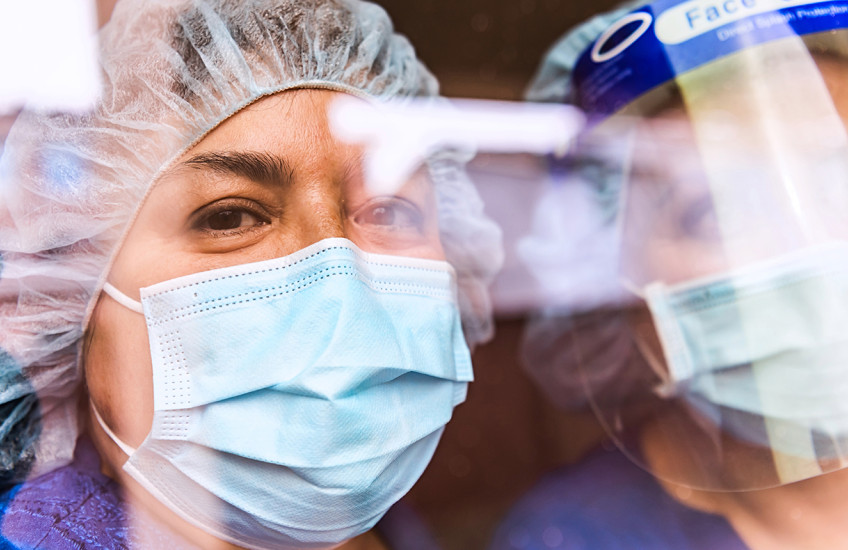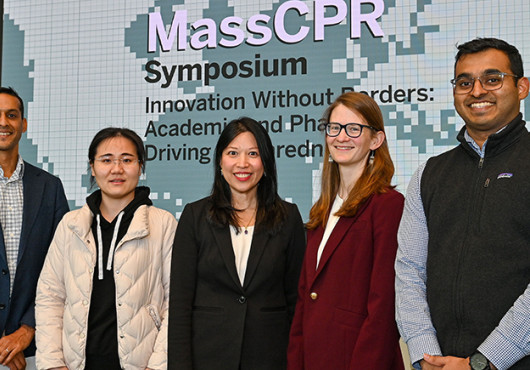This article is part of Harvard Medical School’s continuing coverage of COVID-19.
As the COVID-19 pandemic enters its third year, what lessons have we learned and how do they illuminate our path forward?
Experts from the Harvard Medical School-led Massachusetts Consortium on Pathogen Readiness looked back on the first two years of the pandemic, breaking down the successes and failures in the response to the pandemic on the scientific, clinical, public health, and policy fronts, and discussed how lessons learned should be applied going forward, both in the ongoing fight against COVID-19 and in response to future outbreaks.
- Ruanne Barnabas, chief, division of infectious diseases, Massachusetts General Hospital
- Bill Hanage, associate professor of epidemiology; co-director, Center for Communicable Disease Dynamics at Harvard T.H. Chan School of Public Health
- Bisola Ojikutu, executive director, Boston Public Health Commission; associate professor of medicine, Harvard Medical School
- Jake Lemieux, instructor in medicine, Harvard Medical School, infectious disease specialist at Mass General; viral variants program co-lead for MassCPR
- Jeremy Luban, professor of molecular medicine, biochemistry & molecular biotechnology at UMass Chan Medical School; viral variants program co-lead for MassCPR
Harvard Medicine News: Walk us through what happened in the first months of the pandemic. What did we get wrong, what did we get right?
Hanage: When the outbreak first hit Wuhan, China—a country which is capable of a faster, stricter lockdown than most others—they shut things down quickly. But hospitalizations and deaths continued to increase for four weeks after those lockdowns were in place. Meanwhile, around the world people were more focused on how many cases were relatively mild, instead of moving quickly to prevent the spread of the virus elsewhere. This is the difficulty in making good decisions in the absence of evidence, and in the face of a virus that spreads exponentially. If you make them too late you’ve often baked in a conclusion which is much worse than you would like to be dealing with. There was too much talk, not enough action.
As far as early successes, in places where the pandemic was wrestled to the mat or in the early months, that delayed things until we were able to start learning how to treat the illness. By the time the recovery trial in the UK started reporting its first results in June 2020, just a few months into the pandemic, we knew that dexamethasone was an effective and readily available treatment. People who were infected after that point had far better chances than they would have done beforehand.
This is a key message: If you can delay infections until after effective therapeutics are available, then far fewer people end up being severely ill and dying.
HMNews: How are we doing now?
Hanage: On the one hand, we have developed a number of effective therapeutics, we have effective vaccines. On the other hand, unfortunately, not everyone has access to these critical tools. Many places are dealing with the pandemic in the context of vast historical, structural health care inequities. The WHO has noted that over the course the pandemic 133 countries reported shortages of oxygen, something that’s crucial for dealing with COVID. Going forward we need to assure greater access to these basic necessities for modern medicine.
Social supports are also critical for pandemic response. In the United States, we had substantial support from the central government, with COVID relief checks, but periodic injections of cash cannot replace the kind of structural change we need, like guaranteed sick pay, which will stop people who are ill from going into work and infecting others.
HMNews: Are there other lessons that we still need to learn?
Hanage: We need to do a better job of communicating the importance of having multiple interventions, multiple layers of protection and response. We’ve always wanted to have one single answer, one clever trick that will fix the pandemic, whereas in reality, the answer is a combination of things, including testing, masks, ventilation, vaccines, therapeutics.
We also need to be better prepared to intervene early against an outbreak that can grow exponentially. That means we should discuss “no regrets triggers” for action at a point when things are calm, rather than when we’re in a situation where the outbreak has started and cases are doubling every few days. Once you’re in that situation with a disease like COVID-19, every delay costs lives. If we see something like what we saw in the winter of 2020, which was an extremely severe, highly transmissible respiratory disease outbreak, that should trigger a series of actions automatically to minimize risk. With COVID-19 we should probably have acted several months before we did.
We should talk about what those actions are now and decide so that we’re more prepared the next time.
Ojikutu: As the commissioner of public health with the city of Boston, as an associate professor, and as an infectious disease physician, I totally agree with what you’re saying. But it’s important to highlight that these decisions aren’t made by departments of public health or by academic institutions. These decisions are made by leadership at the city, state, and federal levels. We just need to keep that in mind as we’re thinking about solutions and strategies and be clear about who we need to bring along in the conversation.
HMNews: One of the early struggles with the novel coronavirus was that we didn’t have a clear path to treat the illness. What kind of progress have we made on that front?
Barnabas: The FDA dashboard for COVID-19 shows more than 700 drug development programs in the planning stage. More than 450 trials have been reviewed by the FDA. There are 30 treatments currently authorized under emergency use and two that are fully approved. That’s remarkable progress in such a short time. The first part of the journey was looking at repurposed and redesigned medications, and then monoclonal antibodies really helped us stop severe disease. We’re making excellent progress on finding effective therapies for COVID-19.
Internationally, we’ve had some great examples of how to do large studies quickly and well. The recovery trial that Dr. Hanage mentioned, which was run by the NHS in the U.K., was built on preexisting plans to run multiple clinical trials on a shared platform so they could test successive medications and generate high quality data in a short time frame. That structure is something we should replicate and build on in the future.
HMNews: Early in the pandemic it became clear that, in the U.S., some racial and ethnic groups were bearing the brunt of serious disease and death from COVID-19. Has there been progress addressing those disparities?
Ojikutu: The pandemic has called a lot of attention to the ongoing problems of racial and ethnic health disparities and inspired a lot of great action and advocacy, but health equity and racial disparities remain a prominent and concerning feature of the COVID-19 pandemic.
Based on the most recent data from the CDC, mortality for Black, Latinx, and Indigenous individuals remains approximately twice as high as for white individuals.
In December 2021 and January 2022 peak hospitalization rates amongst Black individuals were nearly four times higher than the hospitalization rates for white individuals.
Baseline inequity and structural racism manifested in many different ways, by disproportionate numbers of people of color who are in the essential workforce, the high rate of underlying comorbidities, lack of access to high quality health care throughout this country, just to name a few factors, contributed significantly and continue to contribute significantly to the inequities we have observed throughout the pandemic.
However, I do believe that we should acknowledge that there was relatively early mobilization and recognition of the inequity that we’ve seen.
I’ve been inspired by the strong response from people of color, both from the community and among professionals in public health and academic medicine, stepping forward to lead the charge, building coalitions, and working on solutions.
HMNews: What are some of the obstacles that have stalled progress?
Ojikutu: One of the most striking obstacles has been the lack of complete and timely data regarding cases, hospitalizations, and deaths by race and ethnicity. Since the very beginning of the pandemic much of the race and ethnicity data nationally have been missing. Only about half of COVID-19 cases reported to the CDC included race or ethnicity identification throughout 2020 into early 2021.
And it’s not just cases, deaths, and hospitalizations that matter. We need to clearly understand whether people of color have equitable access to testing and to therapeutics like monoclonal antibodies and antiviral therapy.
The other piece to this that’s important is that there’s been a shift away from talking about race and ethnicity, or talking about health inequities in an isolated way, and beginning to move the conversation to racism as a root cause of disparities. I believe that the public has begun to think about systemic inequity in a broader sense and to understand that we need to be looking at access to housing and education and employment and criminal justice reform and all these other pieces if we truly want to address disparities related to COVID-19 and beyond.
HMNews: This week the FDA approved the first SARS-CoV-2 vaccines for use in children under 5 years. Can you put that in perspective?
Lemieux: I feel like we are really at a watershed moment in the history of the pandemic.
Cases continue to be extraordinarily high compared to where they have been in the past and where we would want them to be, but we have seen a strong decoupling of cases and deaths, which is due to vaccination and immunity from prior infections.
That is an extraordinarily good place to be compared to where we might have been.
Getting here has come at an exceptionally high cost: the millions of people who have died, the millions of families that no longer have loved ones as a result of this pandemic.
The loss, the grief, is truly extraordinary. At the same time, we are in a place in the pandemic where effective vaccines are available now to all age groups.
In my view, this is one of the last barriers to fall, which is the availability of vaccinations for the under-5 age group, and I think that is just an extraordinary triumph of medical science over the last two and a half years, so I would just encourage everyone to get vaccinated, stay up to date with your dosing, and if you have an under-5 child, as I do, get your child vaccinated and afford them that protection.
The vaccines are safe and effective and that’s been demonstrated through a lot of outstanding work by scientists and clinical trialists.
HMNews: Several people have mentioned the remarkable progress in developing vaccines, diagnostics, and therapeutics for COVID-19. How were we able to move so quickly?
Luban: This remarkable progress is dependent on years of fundamental work that underlies our understanding of viruses generally and our ability to develop technologies that can be applied to vaccination, diagnosis, or treatments.
The first immediate success was how quickly SARS-CoV-2 was discovered, especially if you compare it to some of the other major viral outbreaks in the last century or so.
In the case of the 1918 flu, the agent that caused the disease was not discovered until 15 years later. That meant there was no possibility of having a diagnostic test, a treatment, or a vaccine during the original outbreak.
Decades later, when AIDS hit in the early 1980s, scientists had many more tools available, and so, compared to the 1918 flu, HIV-1 was discovered in a relatively quick two years.
SARS-CoV-2 took a matter of weeks.
Again, this is thanks to investment by our country and by countries around the world in basic, fundamental research. Within weeks of discovery, the genome of SARS-CoV-2 was rapidly sequenced and shared with the international research community. This information powered the creation of vaccines, therapeutics, diagnostics, and tools for genomic epidemiology, which have allowed us to track the movement and mutation of the many variants of the virus.
One of the sobering things to me as a virologist was how few people there were on planet Earth who were really expert in the basic biology of coronaviruses when SARS-CoV-2 hit.
And that’s despite the fact that we already had practice with the virus’s deadly close cousins, SARS-CoV in 2003 and 2004, and the MERS coronavirus that was first identified in 2012.
Largely, I think that’s attributable to the fact that there was a real paucity of funding for basic research on viruses that weren’t an immediate and obvious threat.
We have to think more deeply about how to continue to fund basic research on viruses.
Pox viruses are on the radar again with monkeypox, and just as was the case with coronaviruses two and a half years ago, there are very few poxvirus experts out there, funded to do basic pox research.
And that’s just one example that’s already in the news with another relatively small outbreak underway globally. This is an important issue to consider going forward.
It’s impossible to understate the importance of this kind of research for the security of our nation and the world, potentially for the very survival of civilization.






